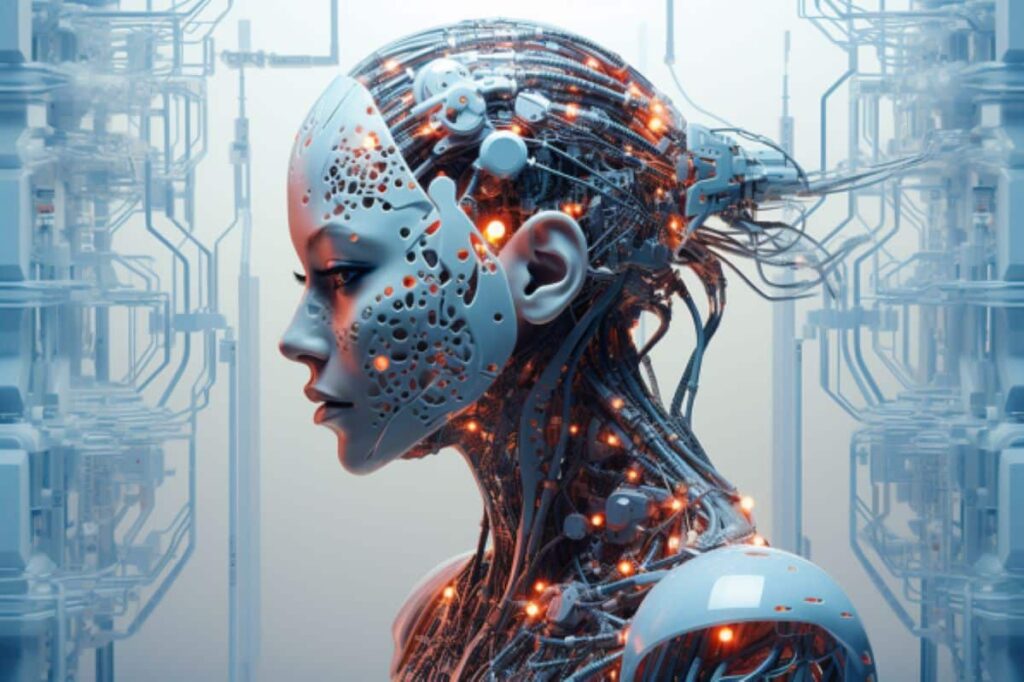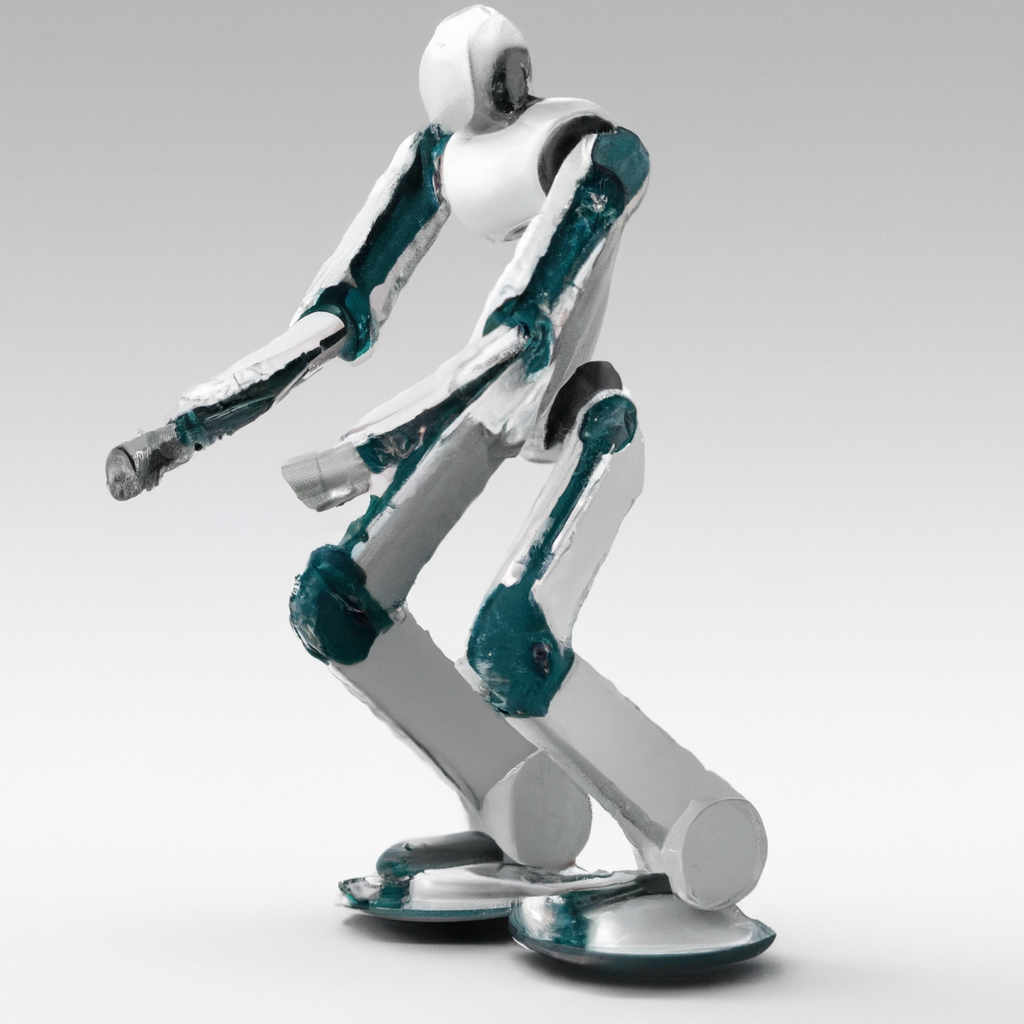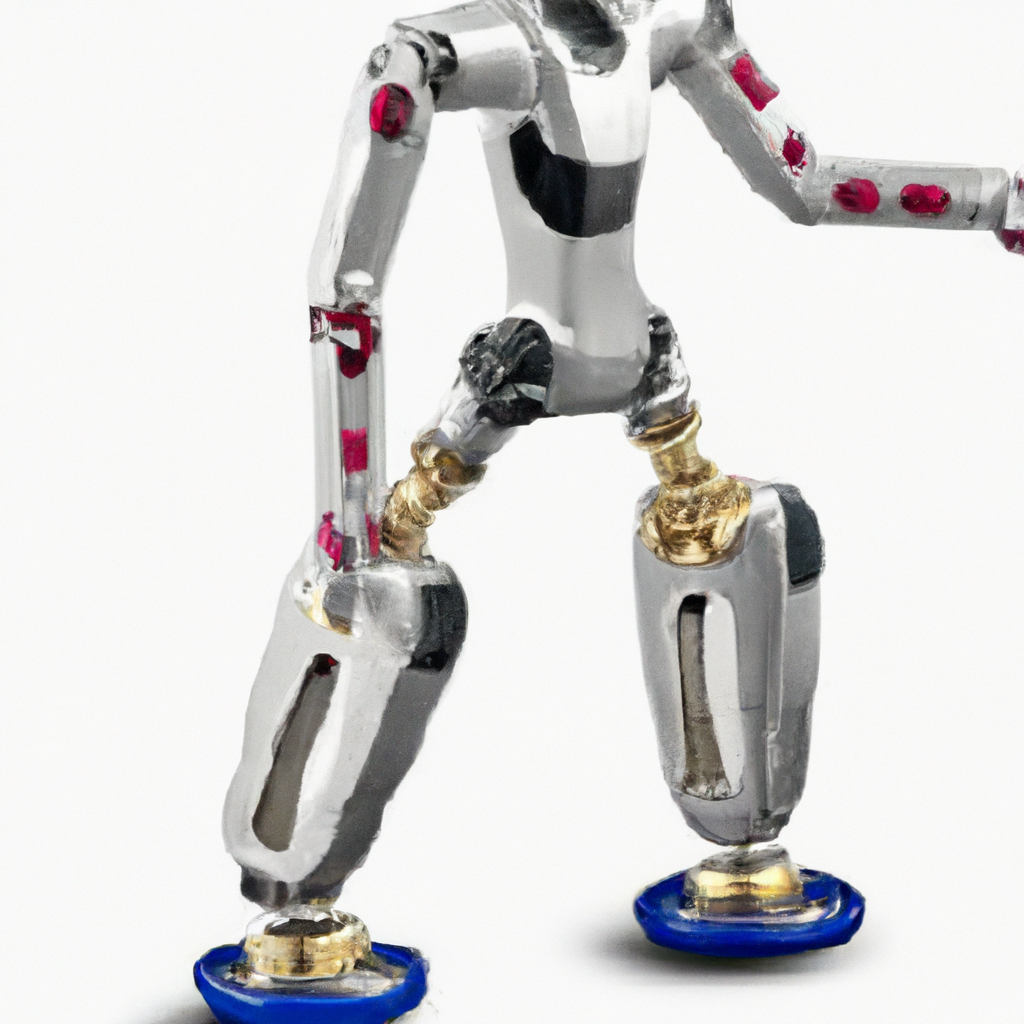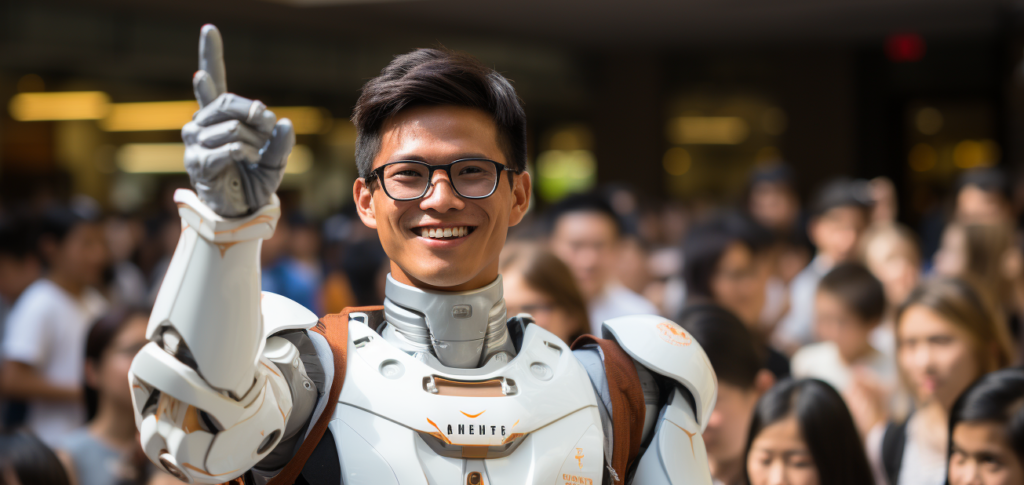Artificial intelligence (AI) has made a stunning breakthrough in the realm of robotics by designing a walking robot in a matter of seconds… in seconds. Welcome to the AI Revolution 2023, things are about to get weird.
Unlike traditional AI models that heavily rely on copious amounts of data and massive computing power, this particular AI operates on a basic laptop, defying expectations.
The AI-designed robot underwent a remarkable transformation, evolving from a stationary block to a three-legged entity capable of steady locomotion.
This accomplishment signifies a paradigm shift in design and innovation, potentially revolutionizing search-and-rescue operations and medical nanotechnology.
Encapsulating billions of years of evolution within its algorithm, the AI compresses this rich history into a rapid design process, allowing for real-time generation of new robot bodies.
The resulting design showcases three legs and a porous body, prioritizing efficiency in terrestrial movement. With the ability to be manufactured en masse, these AI-created robots hold great promise for future applications such as disaster response and medical diagnostics and treatments.
Evolution of AI in Robotics
Artificial intelligence (AI) has revolutionized the field of robotics, providing innovative solutions to traditional models and limitations.
This article will explore the breakthrough in AI-designed walking robots, discussing their design features, efficiency in terrestrial movement, and potential applications in search-and-rescue operations and medical nanotechnology.
Traditional AI Models and Their Limitations
Traditional AI models often rely on massive amounts of data and computing power, making them complex and resource-intensive.
These models struggled to design robots efficiently and effectively, hindering progress in the field. However, with the emergence of AI in the realm of robotics, a paradigm shift occurred, leading to revolutionary advancements.
Revolutionizing Robotics with AI
The introduction of AI in robotics has heralded a new era of design and innovation. Unlike traditional models, AI algorithms can operate on basic laptops, requiring minimal data and computing power.
This unique approach has allowed for the creation of innovative structures from scratch, enabling the development of remarkable walking robots that outperform their traditional counterparts.
AI’s Breakthrough in Designing Walking Robots
A groundbreaking achievement in AI-designed walking robots showcases the remarkable evolution of these machines.
Starting from a stationary block, the AI algorithm transformed it into a three-legged entity capable of steady locomotion.
This rapid transformation highlights the immense advancements made possible by AI and the compression of billions of years of evolution into a real-time design process.
The AI-Designed Walking Robot
The AI-designed walking robot represents an exceptional milestone in the field of robotics. This section will provide an overview of the robot’s design, focusing on its transition from a stationary block to a three-legged entity, its efficiency in terrestrial movement, and its unique design features.
From Stationary Block to Three-Legged Entity
The AI algorithm’s ability to transform a stationary block into a three-legged entity demonstrates the potential for innovation in robotics.
Through a series of iterative processes and optimization techniques, the AI algorithm rapidly evolves the initial design, resulting in a functional and efficient walking robot.
Efficiency in Terrestrial Movement
Efficiency in locomotion is of paramount importance in the design of walking robots.
The AI-designed walking robot embraces this principle, allowing for smooth and agile movement on various terrains.
Through the optimization of leg length, joint flexibility, and balance, the walking robot achieves remarkable efficiency in traversing terrestrial environments.
Overview of the Robot’s Design Features
The AI-designed walking robot boasts several design features that contribute to its exceptional performance.
Firstly, the robot possesses three legs, providing stability and balance during locomotion.
Each leg is equipped with sensors and actuators, allowing for precise movements and adaptability to the environment.
Additionally, the robot’s body is porous, enhancing its performance by reducing weight and increasing overall efficiency.

Paradigm Shift in Design and Innovation
The introduction of AI in the design and innovation of walking robots has brought about a significant paradigm shift.
This section will explore the unparalleled speed and efficiency of AI, its potential applications in search-and-rescue operations and medical nanotechnology, and the implications of this paradigm shift for future advancements.
Unparalleled Speed and Efficiency
The AI algorithm’s ability to compress billions of years of evolution into a rapid design process has revolutionized the speed and efficiency of robotic design.
Traditional models often require extensive time and resources to create functional robots, whereas AI can generate innovative designs in a matter of seconds.
This unparalleled speed and efficiency open new possibilities for rapid prototyping and deployment of robotic systems.
Potential Applications in Search-and-Rescue Operations
The AI-designed walking robot holds promising applications in search-and-rescue operations.
Its enhanced mobility and adaptability enable it to navigate complex and hazardous environments, aiding in the retrieval of survivors during emergencies.
The robot’s ability to traverse uneven terrains, withstand harsh conditions, and detect life signs makes it an invaluable asset in critical situations.
Potential Applications in Medical Nanotechnology
Advancements in AI-designed walking robots also offer potential applications in medical nanotechnology.
The ability of these robots to access hard-to-reach areas within the human body holds promise for non-invasive medical diagnostics and treatments.
The precise movements and sensor capabilities of the robots can be leveraged to deliver targeted therapeutics or perform intricate surgical procedures with minimal invasiveness.
AI Algorithm: Evolution in Real-Time
The fundamental achievement of the AI algorithm lies in its capacity to compress billions of years of evolution into a rapid design process.
This section will explore the mechanism of this algorithm, its rapid design process, and its ability to generate new robot bodies in real-time.
Compressing Billions of Years of Evolution
The AI algorithm harnesses the power of machine learning and evolutionary principles to expedite the design process.
By analyzing vast datasets and simulating evolutionary mechanisms, the algorithm can quickly adapt and optimize designs, compressing billions of years of natural evolution into a matter of seconds.
This novel approach allows for the exploration of countless design possibilities and the emergence of highly efficient robotic systems.
Rapid Design Process
Traditional design processes often involve protracted iterations, extensive manual labor, and substantial costs.
However, with the advent of AI, the design process is revolutionized.
The AI algorithm rapidly generates and evaluates various design iterations, selecting the most efficient and effective ones.
This accelerated design process not only saves time and resources but also enables a deeper exploration of the design space, leading to unparalleled innovation and breakthroughs.
Real-Time Generation of New Robot Bodies
One of the most remarkable capabilities of the AI algorithm is its real-time generation of new robot bodies.
By continuously monitoring the performance and adaptability of existing designs, the algorithm can generate novel body structures that cater to specific requirements and scenarios.
This dynamic and iterative approach empowers the algorithm to adapt the walking robot’s design in real-time, ensuring optimal performance across a wide range of environments and tasks.

AI’s Unique Approach
The unique approach of AI in designing walking robots sets it apart from traditional models.
This section will discuss the minimal data and computing power requirements of AI, its ability to design innovative structures from scratch, and its compatibility with basic laptops.
Minimal Data and Computing Power Requirements
Unlike traditional AI models that relied on vast amounts of data and computing power, the AI algorithm developed for walking robot design operates on minimal resources.
This reduction in data and computing power requirements makes AI more accessible, allowing researchers and engineers to leverage its capabilities using basic laptops or low-resource computing systems.
The efficiency of the AI algorithm ensures that innovative robot designs can be generated without the need for extensive computational infrastructure.
Designing Innovative Structures from Scratch
The AI algorithm’s ability to design innovative structures from scratch is a testament to its ingenuity and adaptability.
Instead of relying on pre-existing blueprints or templates, the algorithm explores the design space, creating solutions tailored to the specified objectives and constraints.
This capacity for creative problem-solving allows AI-designed walking robots to surpass the limitations of traditional models, enabling breakthroughs in performance and functionality.
Compatibility with Basic Laptops
The compatibility of the AI algorithm with basic laptops is a significant advantage in terms of accessibility and usability.
Unlike resource-intensive AI models that necessitate specialized infrastructure, the AI algorithm can operate on widely available computing devices.
This compatibility empowers researchers and engineers worldwide to leverage AI in their robotics endeavors, fostering widespread innovation and collaboration across disciplines.
The Design of the Walking Robot
The design of the walking robot is instrumental in achieving optimal performance and efficiency.
This section will delve into the key design features of the AI-designed walking robot, including its three-leg configuration for stability, its porous body for enhanced performance, and the delicate balance between efficiency and functionality.
Three Legs for Stability
The walking robot’s three-legged configuration is a critical design feature that ensures stability during locomotion.
Each leg is strategically positioned to distribute weight evenly and maximize balance.
The three-legged structure minimizes the risk of toppling over and enables the robot to traverse uneven or challenging terrains more effectively.
Through a combination of sensors, actuators, and advanced control systems, the walking robot achieves seamless coordination and stability.
Porous Body for Enhanced Performance
The porous body of the walking robot serves as a design feature to enhance its overall performance.
By incorporating a porous structure, the robot achieves weight reduction without compromising structural integrity. The porous body allows for improved energy efficiency and minimizes unnecessary stress on the robot’s components during locomotion.
Additionally, the porosity enhances the robot’s ability to withstand external forces, enhancing its durability and robustness in demanding environments.
AI Revolution 2023: Balancing Efficiency and Functionality
The design of the walking robot strikes a delicate balance between efficiency and functionality.
While prioritizing efficiency in locomotion, the robot’s design accounts for its intended applications and tasks.
Through meticulous optimization, the AI algorithm ensures that the walking robot can perform tasks efficiently without sacrificing essential functionality.
This balance is critical in maximizing the robot’s utility and versatility across various real-world scenarios.

Manufacturability and Future Applications
The AI-created walking robots have the potential for widespread manufacturability and future applications.
This section will discuss the feasibility of manufacturing AI-created robots, their potential applications in disaster response scenarios, and their relevance to medical diagnostics and treatments.
AI-Created Robots: Manufacturing Feasibility
The manufacturability of AI-created robots is a crucial factor in their potential for real-world applications.
The AI algorithm streamlines the design process, optimizing the manufacturing specifications alongside performance requirements.
By generating robot designs that can be efficiently manufactured using existing technologies and materials, the AI algorithm ensures that the creations are not solely confined to the realm of research and development but can be readily manufactured for practical use.
Disaster Response Applications
The AI-designed walking robots hold immense promise in the field of disaster response.
The robots can navigate treacherous terrains, assess structural stability, and provide critical information for rescue teams.
Equipped with advanced sensors and communication capabilities, these robots can help search for survivors, deliver supplies, and aid in the overall coordination of rescue operations.
The efficiency and adaptability of AI-designed walking robots make them invaluable assets in mitigating the impact of natural disasters and improving response capabilities.
Medical Diagnostics and Treatments
In addition to disaster response applications, AI-designed walking robots have the potential to revolutionize medical diagnostics and treatments.
Minimally invasive procedures, such as targeted drug delivery or localized treatment, can be facilitated by these robots’ precise movements and sensor capabilities.
The ability to access hard-to-reach areas within the human body with minimal invasiveness opens new opportunities for enhanced medical diagnoses, surgeries, and therapies.
The AI algorithm’s capacity to generate specialized robot bodies tailored to specific medical applications amplifies its potential impact in advancing healthcare.
In conclusion, the evolution of AI in robotics has revolutionized the field, paving the way for AI-designed walking robots that surpass traditional models’ limitations.
With the ability to generate innovative structures and compress billions of years of evolution into real-time design processes, these robots achieve unparalleled speed, efficiency, and adaptability.
The compatibility with basic laptops, minimal data and computing power requirements, and the unique approach of the AI algorithm allow for widespread accessibility and usability.
The design of the walking robot, with its three-leg configuration, porous body, and optimized balance between efficiency and functionality, ensures optimal performance.
Moreover, the manufacturability of AI-created walking robots, as well as their potential applications in disaster response scenarios and medical diagnostics and treatments, open new frontiers in robotics and healthcare.
As AI continues to advance, the fusion of artificial intelligence and robotics holds immense promise for future innovation and societal impact.

